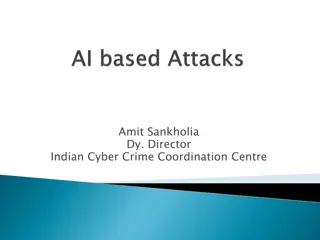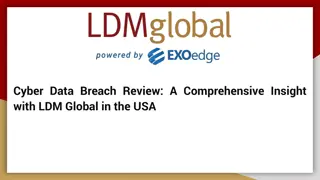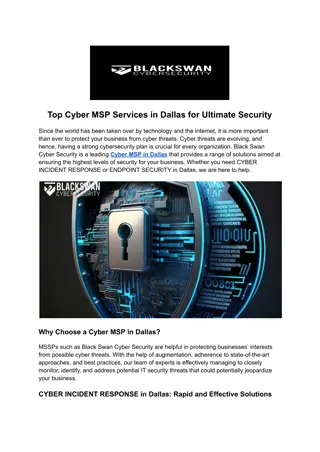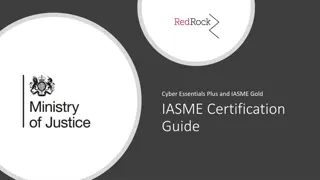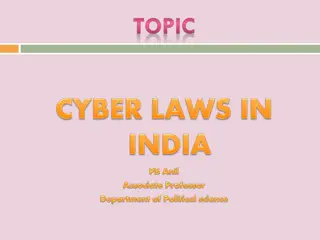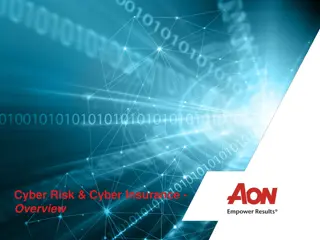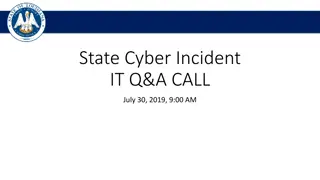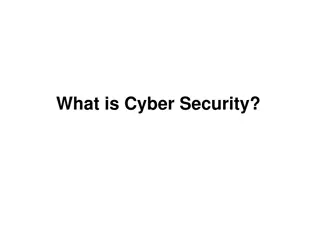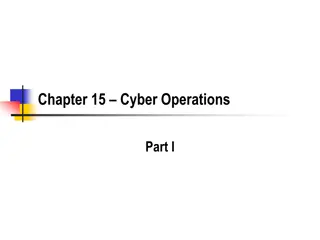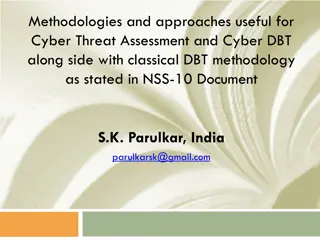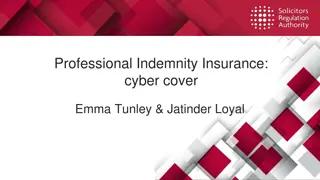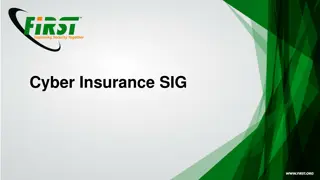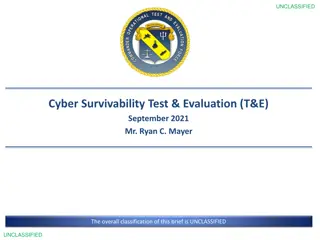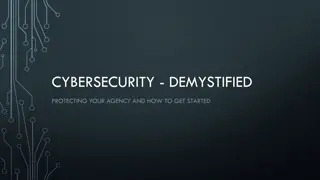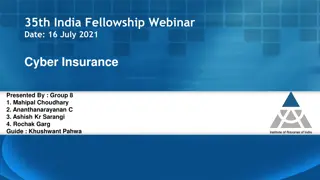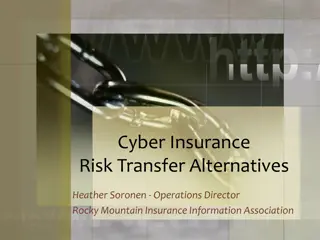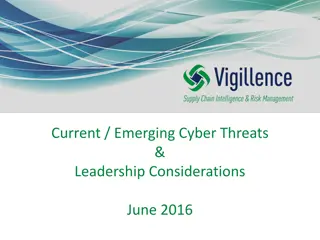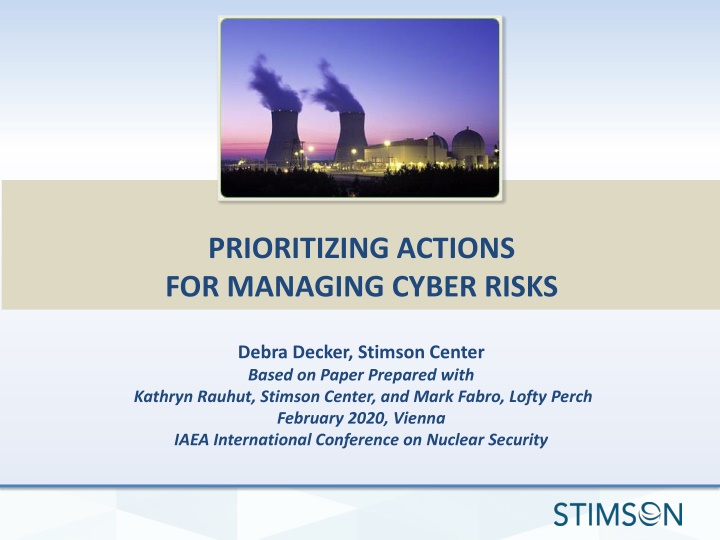
Prioritizing Actions for Managing Cyber Risks
Overview of trends in cyber risk elements including threats, vulnerabilities, and consequences. Recommendations for prioritizing risk management for licensees and international organizations. Importance of resilience in cybersecurity.
Download Presentation

Please find below an Image/Link to download the presentation.
The content on the website is provided AS IS for your information and personal use only. It may not be sold, licensed, or shared on other websites without obtaining consent from the author. If you encounter any issues during the download, it is possible that the publisher has removed the file from their server.
You are allowed to download the files provided on this website for personal or commercial use, subject to the condition that they are used lawfully. All files are the property of their respective owners.
The content on the website is provided AS IS for your information and personal use only. It may not be sold, licensed, or shared on other websites without obtaining consent from the author.
E N D
Presentation Transcript
PRIORITIZING ACTIONS FOR MANAGING CYBER RISKS Debra Decker, Stimson Center Based on Paper Prepared with Kathryn Rauhut, Stimson Center, and Mark Fabro, Lofty Perch February 2020, Vienna IAEA International Conference on Nuclear Security
Overview Trends in Risk Elements o Threats o Vulnerabilities o Consequences Spoiler alert: Resilience is key! Recommendations for Prioritizing Risk Management For Licensees For International Organizations and Others Cybersecurity strives to preserve the availability and integrity of the networks and infrastructure and the confidentiality of the information contained therein. EU definition
Threats Old World IP theft Modification/loss/acquisition of information New World Persistent presence in critical infrastructure both IT and OT Targeted APT: State and Non-State
Vulnerabilities Increasing digitization Supply chain and other third-party vulnerabilities 5G? AI and Distributed Ledger Technology? Other: Robotics, Electronic Devices .
Consequences Secure, accurate, fast communication and responses needed Challenges! Social media Deepfakes Insufficient planning/exercising Bottomline: Defense in depth and response management are critical!
Risk Management: Licensees Compliance necessary but insufficient Reduce vulnerabilities -Good cyber hygiene - Awareness training and certifications, automated protections, credential protection -Information sharing - But who should do and how? - Trusted partners? Broader response planning/training
Risk Management: IAEA+ More emergency practices Information sharing Incident disclosure system like ITDB Use common scoring system Pair with A/CPPNM RevCon Develop tool to demonstrate compliance+ More timely updates on good practices Leverage others, e.g., COEs, electric utilities
Agile management and cooperative approaches needed to address new and evolving risks! Thank you Debra Decker, Stimson Center ddecker@stimson.org Prioritizing Actions for Managing Cybersecurity Risks can be accessed in the IAEA 2020 ICONS Conference Report Paper # 352 and at www.stimson.org under the Nuclear Security Program Image Credits Slide 1: Vogtle nuclear power plant, Georgia, USA: edited by BlatantWorld.com, and are re-released into the Public Domain Slide 2: Control room for Unit 1, Donald C. Cook Nuclear Plant, Bridgman Michigan, USA: US Department of Energy photo
Types of Info Sharing -Incidents! -Like IAEA Incident and Trafficking Database -Common scoring systems -Look at those deemed safety incidents from cyber Look to other industries, too esp. for OT events but https://www.risidata.com/Database out of date - Also, NTI cyber reg assessment out of date. General Data Protection Regulation (GDPR), which provides necessary actions in response to disclosures, and repositories such as CVE [Common Vulnerabilities and Exposures] would help facilitate research in this topic. Negatives: The challenge is ensuring that shared information does not bolster attacker capability. Differing OT systems means lessons learned harder to do. Risk reduction may not be worth the effort
Types of Info Sharing -Legal and regulatory approaches -Look across States, IAEA undertake? -Pair with A/CPPNM RevCon? -Leverage others! -NATO Cooperative Cyber Defense Centre of Excellence (CCDCOE) -Utilities, industries? Dashboard / series of metrics to enable all jurisdictions to demonstrate compliance and standards might be a good, common tool North American Electric Reliability Corporation (NERC)/Critical Infrastructure Protection (CIP) standards are mandatory for the electrical power industry
Types of Info Sharing -Suppliers and supplies -Public certifications -Black/white lists Internationally-recognised certification of suppliers of Operational Technology, in addition to certification for IT security maturity, emerges as a practical ambition which brings the other facets together. This could serve to improve standards, make procurement decisions easier and enable a graded (and therefore more proportionate) approach, which should reduce costs in the longer term. It could also enable the cyber insurance market to reach a higher level of maturity. NGOs could assist in this ambition, so far (in the UK at least) nuclear industry group efforts have had limited success.
Threat Landscape Nuclear specific Stuxnet Black Energy Duqu Flame KHNP DoE 2011 2012 2013 2014 2015 2016 General industry Regin RSA Ukraine Power Grid German Steelmill v
The Risks are Complicated! NIST 1.1 Framework


